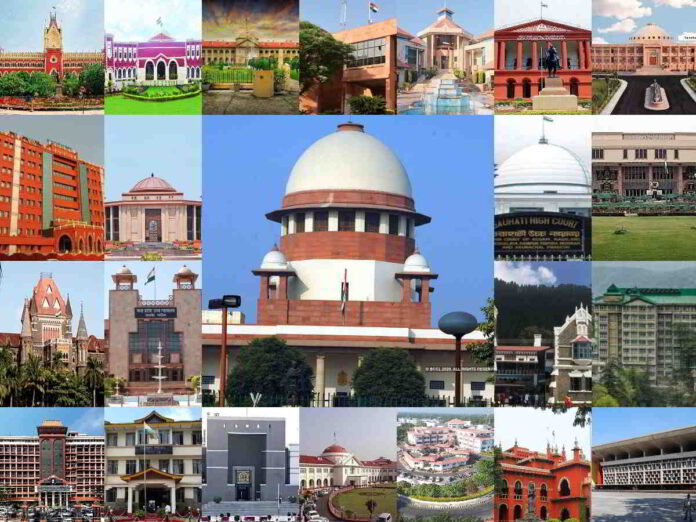The Indian Judicial System is derived from the Constitution, which establishes that the Courts be divided into two – Superior and Subordinate. The Superior Courts are the Supreme and the High Court, while all the other courts such as District and Special Courts come under Subordinate.
There are multiple High Courts, with some having more than one bench (branch). The Supreme Court lives in New Delhi. Unlike the High Courts, the Apex Court has only one location; only one bench. However, there have always been talks for there to be Benches of the Supreme Court throughout various regions in the country.
Recently, five Bar Councils from South India requested for a Bench of the Supreme Court in the South. Also, senior lawyer and Rajya Sabha member P. Wilson introduced a Private Member Bill in 2020 that sought to establish four regional benches of the Apex Court. This bill would amend Article 130 providing for regional Benches of the Supreme Court at New Delhi, Mumbai, Chennai and Kolkata. This discussion is, however, not new.
It has been discussed in various law commission reports and well as with the Supreme Court. Looking at the immense population and overflowing caseload of the Indian Judiciary, having a few benches of the Apex Court seems like a decent solution.
Law Commission on Regional Benches:
Historically, the number of Supreme Court Judges has been increased on various instances. But merely increasing the number of judges is not a way of speedy trial of cases. The 95th, 120th, 125th, and 229th Law Commission reports have recommended setting up regional benches.
The 95th report in 1984 stated “the Supreme Court of India should consist of two Divisions, namely (a) Constitutional Division, and (b) Legal Division”, and that “only matters of Constitutional law may be assigned to the proposed Constitutional Division”.
The 120th Report in 1987 talked about the manpower planning in the judiciary. It talked about the problem of having fewer judges in comparison to the growing caseload of the judiciary.
Also Read
The 125th Report in 1988 reiterated the recommendation for splitting the Supreme Court into two halves; as suspected in the 95th report. It further said, “… The Government of India, on a couple of occasions, sought the opinion of the Supreme Court of India for setting up a Bench in the South. ….those coming from distant places like Tamil Nadu in the South, Gujarat in the West and Assam and other States in the East spend a huge amount on travel to reach the Supreme Court.”
Thereafter, the 229th Report in 2009 recommended, “a Constitution Bench be set up at Delhi to deal with constitutional and other allied issues…and four Cassation Benches be set up in the Northern region/zone at Delhi, the Southern region/zone at Chennai/Hyderabad, the Eastern region/zone at Kolkata and the Western region/zone at Mumbai to deal with all appellate work arising out of the orders/judgments of the High Courts of the particular region”. Cassation Benches (or courts) are those that only interpret the relevant law. They are appellate courts of the highest instance. These would decide cases involving non-Constitutional disputes from lower courts.
Parliamentary view:
Other than the law commission, the Parliamentary Standing Committee on Law and Justice has repeatedly stated this view, in promotion of speedy justice to the common man. Its 15th report stated, “The Committee has been recommending time and again for setting up of benches of the Supreme Court in far-flung areas, with a view to providing justice to the poor, for whom it is impossible to visit the national capital……..The Committee, therefore, endorses its earlier view that establishment of benches of the Supreme Court in other parts of the country would be of immense help to the poor who cannot afford to travel from their native places to Delhi.”
If we look at the cases that are appealed in the Supreme Court, it is largely found that geographical proximity largely influences the appeal rate. Thus, the closer a state is to New Delhi, the higher the chances of appeal to the Supreme Court. Appeals from the High Court of Punjab and Haryana constitute the majority consequently being 90% of the output of two-judge benches. Hence, it is very rare to see any appeal from the High Courts in North East or those from South India.
Thus, the main argument of setting up Cassation benches and regional benches stems as the solution of overflowing case load for the judiciary and reduction in litigation cost to the common man. Further, Article 39A of the Constitution of India provides that “the state shall secure that the operation of the legal system promotes justice, on a basis of equal opportunity, and shall… ensure that opportunities for securing justice are not denied to any citizen by reason of economic or other disabilities.” It is on this basis that the Parliamentary Standing Committee has backed its suggestions. Coming to Delhi and engaging with the affairs of the Supreme Court is beyond the means of the common man.
Supreme Court’s View on Virtual Courts:
Even though the Law Commission reports as well as the Parliamentary committee on multiple occasions has suggested regional benches of the court, the Supreme Court itself is not of the same view. Whenever the topic has come up before the court, it keeps the opinion that regional benches will dilute the prestige of the court. A provision in this regard is already in the Constitution, giving power to the Chief Justice of India to sit the Supreme Court in Delhi or in such other places or places with the approval of the President from time to time. Thus, the chief justice can set up other Benches of the court. Currently however, this provision has not been invoked.
On the flip side, the Supreme Court has been forward with the modern way of Courts – Virtual Courts. The dawn of the Covid-19 pandemic has definitely brought the future of Indian Judiciary closer. The shift from offline to online courts has been monumental, and this change has been embraced with open arms. Technology has paved its way into bringing justice.
In the matter of virtual courts, a bench headed by CJI SA Bobde stated that they are as good as Open Court hearings. Virtual Courts are a boon to the entire Legal Fraternity. Digital Justice is cheaper and faster; is affordable, citizen-friendly and offers greater access to justice. Virtual Courts set up during the pandemic have been a great success. Over 18 lakh pleas were filed across India out of which over 7,90,112 are already disposed of. Subordinate Courts handled over 7.3 lakh cases virtually as well.
Regional Benches and Virtual Courts:
As stated earlier, the cost of setting up regional benches will be extreme. The resources for building regional benches could be utilized to strengthen the digital infrastructure and enhance the reach of virtual courts. This new era of virtual courts would help in addressing the locational and economic handicaps, and thus, the cost-benefit ratio for investing in virtual courts is more than regional benches.
Those in favor of Regional Benches may argue that there are certain limitations to going virtual such as lack of digital infrastructure in courts, connectivity in rural areas, technologically inexperienced lawyers etc. In response to this, stand the Department of Justice’s schemes and initiatives which tackle issues related to digital infrastructure in courts such as the E-courts Project. Under the project, various district and subordinate courts have been completely computerized and enabled with Information and Communications Technology. E-filing has been made possible from anywhere in India. Another scheme by the Department is Tele Law services, which delivers legal advice through a panel of lawyers stationed at the State Legal Services Authorities and Common Services Centers (CSC) to the disadvantaged and marginalized. The DoJ has played a large part in digitalizing the judiciary.
While one can always claim that in-person courts are better, with virtual courts not only can the costs required for setting up be diminished, but also time will be saved; Thus giving the phrase, “Justice delayed is Justice Denied” a true meaning.
Story by Sai Kulkarni – Intern




